August 31, 2012
Air Date: August 31, 2012
FULL SHOW
SEGMENTS

GMO Trees
View the page for this story
Scientists are developing genetically modified trees for the forests of the future. Ann Peterman of the Global Justice Ecology Program tells host Bruce Gellerman that these designer trees don't measure up wo what a real forest provides. (05:00)

Water Footprinting
View the page for this story
Water is necessary for all life on Earth. It’s also necessary to produce the goods and products we consume. Just how much water goes into making your hamburger or the jeans you’re wearing? It’s called a “water footprint” and as global water supplies dwindle, some are trying to raise awareness about the water cost of our daily consumption. Host Bruce Gellerman talks with Derk Kuiper, executive director of the Water Footprint Network. He also speaks with Michael Kobori of Levi-Strauss to find out what his company is doing to curb its water use. (06:15)

Skin Color and Vitamin D
/ Ashley AhearnView the page for this story
Some 70 percent of Americans are vitamin D deficient. That’s according to the Centers for Disease Control. People get vitamin D from sunshine but those with darker skin need more sun than others. African Americans are more likely to have insufficient amounts of vitamin D than whites, and, as Ashley Ahearn reports, that makes them more likely to get certain types of diseases like cancer and diabetes. (07:00)

Family Farmacia
/ Antony JaureguiView the page for this story
Traditional Mexican botanical medicine was alive and well when Antony Jauregui (HOW-re-gee) was growing up in Los Angeles. Now the Youth Radio reporter is trying to make sure he learns everything he can about it from his mother and other Latino naturalists. (06:15)

Michael Recycle
View the page for this story
Shooting through the sky with a cooking-pot hat and tin can elbow pads, super hero Michael Recycle has a mission: to get kids recycling. Host Bruce Gellerman turns to nine-year-old Anna Carton-Smith for a review of the book, “Michael Recycle” by Ellie Bethel. (05:10)

The Writing on the Wall
/ Jim WilliamsView the page for this story
Graffiti is plaguing many of our nation’s national parks and monuments, including some ancient Native American cliff dwellings. At Bandelier National Monument in New Mexico, conservators from a government program are taking advice from Natives, whose ancestors built these ancient sites, to make sure the restoration is done appropriately. KUNM’s Jim Williams reports. (07:00)

The Language of Landscape
View the page for this story
Living on Earth continues its series exploring features of the American landscape. Its based on the book Home Ground: Language for an American Landscape, edited by Barry Lopez and Debra Gwartney. In this installment, Pattiann Rogers takes a refreshing look at the desert “kiss tank.” (01:30)

Eco Elvis
View the page for this story
Eco Elvis is alive and well in Kansas City, Missouri. He’s recycled a dozen of his favorite songs to address environmental issues and performs for audiences of all ages. His alter ego, Matt Riggs, talks with host Bruce Gellerman. (08:20)
Show Credits and Funders
Show Transcript
Host: Bruce Gellerman
Guests: Ann Peterman, Derk Kuiper, Michael Kobori, Anna Carton-Smith, Matt Riggs
Reporters: Ashley Ahearn, Antony Jáuregui, Jim Williams
Note: Pattiann Rogers
[THEME]
GELLERMAN: From Public Radio International - this is Living on Earth.
[THEME]
GELLERMAN: I’m Bruce Gellerman. By paying to protect forests abroad, the United States could help meet its green house gas goals at home. But not all forests – or all trees are created equal.
PETERMAN: Forests in tropical regions store four times the carbon of a tree plantation. So, when you destroy a natural forest and replace it with a tree plantation you have just decimated the ability of that land to store carbon.
GELLERMAN: Also – Vitamin D – as in deficiency. And… the king is dead…long live Eco Elvis:
RIGGS: I want you, I need you, I love you is the song it’s based on – and I was thinking – “hmm that’s got three words and “reduce reuse and recycle” is three words” – and it went from there.
[MUSIC: Eco-Elvis "I Reduce, I Reuse and I Recycle" from 'Burnin' Globe' (Matt Riggs – 2006)]
GELLERMAN: This week on Living on Earth. Stick around!
[THEME]
PRI ANNOUNCER: Support for Living on Earth comes from the National Science Foundation and Stonyfield Farm.
GMO Trees
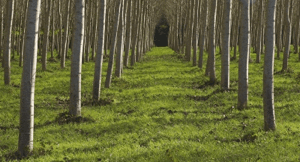
(Photo: Andy Coulson)
GELLERMAN: From the Jennifer and Ted Stanley studios in Somerville, Massachusetts, this is and encore edition of Living on Earth. I'm Bruce Gellerman
Preserving the world's tropical forests holds great promise for reducing greenhouse gas emissions…but not all forests are created equal. There are natural forests, which are home to a wide variety of trees, plants and animal life, and then there are forest plantations - where a single type of tree is grown for its commercial value. Scientists are now experimenting with plantations, manipulating and modifying the genes of saplings that grow in these monoculture forests - and that’s a problem says Ann Peterman. She’s executive director of the Global Justice Ecology Project.
PETERMAN: One of the main trees that they're genetically engineering is eucalyptus. But they're also genetically engineering poplars and pines, so those three species are pretty much the three main forestry trees that they're genetically engineering. And they're mainly doing it either for pulp and paper, for cellulosic fuel – in other words biofuels made out of trees – or for timber, in the case of some of the pine. So they're genetically modifying them to enhance some of the traits.
.gif)
Ann Peterman explaining the ecological risks of genetically engineered trees at the UN Convention on Biological Diversity. (Photo: Orin Langelle)
GELLERMAN: When you say "they" you're talking about companies.
PETERMAN: Right, I'm talking about the paper industry, the biofuels industry, etc.
GELLERMAN: What's the problem. I mean, they're saying we need to be more sustainable, we need to grow sustainable products, provide for an ever-expanding population and this is good.
PETERMAN: Their argument is that this will grow more wood on less land. Less forest will be cut down because we can concentrate the amount of timber that we're growing on a piece of land. But as we've seen with traditional plantations that are already developed all over the world, they do not protect forests, they destroy forests. And the reason is because plantations are worth more money than natural forests. They can get more timber out of them or they can get a specific kind of timber out of them. In a natural forest they can't do that. So, it's worth more money.
GELLERMAN: So what you're saying is, it's a driver of deforestation. They would go in and they would deforest a natural rainforest or tropical forest. And then plant these plantation forests.
PETERMAN: Exactly, and you see that in Brazil. They've pretty much decimated the Mata Atlantica forest ecosystem in Brazil to replace them with eucalyptus plantations. Now they're talking about going into the Amazon and replacing parts of the Amazon with eucalyptus plantations. So, yes, tree plantations have been a huge driver of deforestation all over the world.
GELLERMAN: But a tree is a tree is a tree. I mean, if you cut down a tree and you're planting genetically modified eucalyptus in terms of carbon, is there a difference?
PETERMAN: There is actually, there's a huge difference. And it's not just, of course, the carbon storage, but the biodiversity, you know, the ability of the forest to sustain populations, human populations in a way that plantations can't. But getting back to the carbon issue, forests in tropical regions store four times the carbon of a tree plantation.

Tree plantations are usually a single species of tree. (Photo: Andy Coulson)
GELLERMAN: In Brazil they are planning to count plantation trees as forest.
PETERMAN: Yeah, they do in many parts of the world. The UN allows plantations to be considered as forest. It's just an incredible bad definition of forest that the UN uses that allows this to happen and that desperately needs to be changed. In Brazil they call tree plantations green deserts because they're so destructive and because they are basically devoid of any other species except the monoculture of that tree.
GELLERMAN: And where on the planet is the number one place where they're planting genetically engineered trees?
PETERMAN: China, at this point. China's the only place in the world where they have commercially released genetically engineered trees at this point. The U.S. is in the process of trying to figure out if they want them to be legal here, Brazil is in a similar process, they're moving forward with it. But China is the only place where they actually have commercial plantations.
GELLERMAN: Ann Peterman coordinates work on genetic trees for the Global Forest Coalition and directs the Global Justice Ecology Project.
Related link:
Global Justice Ecology Project
[MUSIC: Charlie Hunter, Chinna Smith, & Ernest Ranglin “Rivers of Babylon” from “Earth Tones” (Greenstreets 2005)]
Water Footprinting
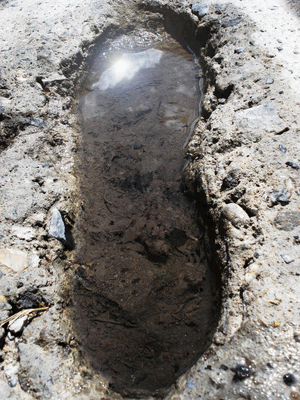
GELLERMAN: The next time you're shopping for a pair of leather shoes - consider this: it took 21 hundred gallons of water to produce them.
21 hundred gallons for one pair of shoes - that's the shoes' water footprint. A water footprint is a new way of looking at the economic costs and environmental impacts of water in the everyday things we use.
Derk Kuiper is Executive Director of the Water Footprint Network in the Netherlands.
KUIPER: What this number tells you is basically not only direct use from the tap, but it's also the indirect use that you have through consumer products or producing those products, and you can actually start understanding the amount of water you're shipping around the world.
GELLERMAN: Lemme get my water footprint for some common products, okay?
KUIPER: Yeah.
GELLERMAN: How about making a hamburger? How much water goes into making a hamburger?
KUIPER: It's about sort of 2.7 thousand liters of water that goes in there.
GELLERMAN: That's about what – 630 gallons of water for one hamburger.
KUIPER: Yeah.
GELLERMAN: How about a glass of beer?
KUIPER: A glass of beer is basically 75 liters of water, well you're obviously not drinking that physically, but at least the water has been used in the production of, for example, the hops and wheat that is being used for brewing the beer.
GELLERMAN: Seventy-five liters, that's about 20 gallons.
KUIPER: Yes.
GELLERMAN: So the idea is that like a carbon footprint has a certain impact on the planet, then your water footprint has a similar impact.
KUIPER: Yeah, there's one complicating factor with water is the carbon is basically pooled in the atmosphere and water is very locally based, so the impacts of your water footprint are actually quite diverse. So, for example, if you look at water rich regions like the Amazon area, the impact of your water use there might be far less than for example in a water scarce area in eastern Africa. So, you need to have a very specific measure of the localized impacts and that complicates matters.
GELLERMAN: Ah, so when you're talking footprint, you're actually talking impression in a local area.
KUIPER: In the end you will do that, but the question is at this point, we cannot yet do that. We are developing that and that's also why we have the Water Footprint Network. We want to develop that methodology further to actually start understanding what the volume that you have to have in your water footprint is actually having for an impact in a local situation.
GELLERMAN: Well the idea of a water footprint is, I understand, is becoming more and more popular in the business world. They're actually starting to consider how much water they're using in producing the products they produce.
KUIPER: You know, in light of their sort of corporate citizenship and stewardship, the best way to understand how the impact on the world. And there's not only impact on the natural environment, also people. And water is one of those sort of key topics now after climate change, because some of the stress on water resources in areas like, for example, Pakistan and so on, is huge, and they need to do something about it. Because otherwise they might actually run great, not only reputational risk, but also fiscal risks in terms of having their supply chains falling apart.
GELLERMAN: Well Mr. Kuiper, thanks a lot. I appreciate it.
KUIPER: Thank you very much.
GELLERMAN: Derk Kuiper of the Water Footprint Network
About 90 percent of the water used each year in developing countries goes to agriculture. Crops like cotton are notoriously thirsty - so things made from cotton – say blue jeans - have a large water footprint.
How large? The answer from Michael Kobori, vice president at Levi-Strauss & Company, might surprise you.
KOBORI: It takes 919 gallons of water to produce a pair of our flagship product, which is, as I'm sure you know, Levis 501s.
GELLERMAN: Those are the ones with the buttons, no zipper.
KOBORI: That's correct.
GELLERMAN: Nine hundred and nineteen gallons for one pair of jeans?
KOBORI: Yes, and I should explain how we arrived at that figure. A few years ago what we did was a product life cycle assessment. So from the raw materials, growing the cotton, through manufacturing, distribution, consuming use and final disposal.
GELLERMAN: So what does that make your water footprint?
KOBORI: So, what this means for us, Bruce, as we look at the breakdown here. We actually didn't focus on the cotton or the consumer immediately. What we did was we focused on the little less than six percent that we actually control in our manufacturing of the product. And the largest amount of that is taken up in the industrial laundries around the world that wash the product to get the different finishes that you see on the pair of 501s.
So we took a look at the quality of that water and the nice things that's happened is as those laundries have constructed these treatment facilities, what that's enabled them to do is actually in most cases recycle more of the water so their actual use of the water has dropped.
So in some cases the laundries are able to recycle seventy to eighty percent of the water. So as the cost of water begins to increase in a number of countries around the world, just because water is becoming more of a scarce commodity, having treatment facilities, having the recycling programs has enabled our suppliers to avoid paying increased fees in some cases, both for water and for the disposal of the discharge of the water. In some of our laundries, they're saving up to a $100,000 a year.
GELLERMAN: Water's going to be scarcer still when global warming hits full bloom. What are you planning to do there in the future?
KOBORI: Well, so in the future, we're starting to look at the bigger sections of that life cycle. So the cotton and the consumer use. And we've been working with experts as well as others in the industry to understand the water impact of cotton better, and what we can do about it. We know we need to do something, even if we don't directly buy the cotton, we work with fabric mills that purchase the cotton, so we've trying to figure out what can we do around supporting more sustainable cotton.
GELLERMAN: Well what can I do? I mean, I'm wearing a pair of your jeans right now.
KOBORI: What you can do is wash less. What we've done is begun to change the way we communicate to our consumers about their care of the product. So with what we call our eco product, which is this product that is made out of recycled denim or organic cotton, we've changed the label on the product to say to consumers "wash only when necessary in cold water and line dry if possible." It's better for your jeans and it’s better for the environment.
GELLERMAN: Well Mr. Kobori, thank you very much.
KOBORI: You're very welcome, Bruce.
GELLERMAN: Michael Kobori is a Vice President of Supply Chain Social and Environmental Sustainability at Levi-Strauss.
Related link:
Water Footprint Network
[MUSIC: Azymuth “Last Summer in Rio” from “Telecommunication” (Milestone Records 1982)]
GELLERMAN: Just ahead, vitamin D—D for deficient. Keep listening to Living on Earth.
[MUSIC: S.M.V. “Mongoose Walk” from “Thunder” (Heads Up 2008)]
Skin Color and Vitamin D
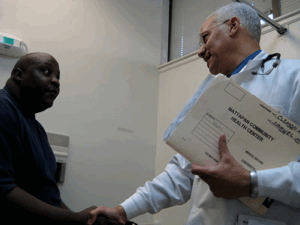
Samuel Clemens talks with his doctor, Douglass Bibuld, about vitamin D at a recent check up at Mattapan Community Health Center in Boston.
GELLERMAN: It’s an encore edition of Living on Earth, I’m Bruce Gellerman. There are a few things you should know about Vitamin D. First - It’s not a vitamin: in the body it acts like a hormone, and it plays a critical role in making bones strong, beefing up the immune system and regulating the growth of cells.
Not having enough Vitamin D may increase your chances of getting certain cancers, osteoporosis, diabetes - even Parkinson’s Disease - and the Centers for Disease Control says 70 percent of us don’t get enough. Vitamin D is called ”the Sunshine Vitamin” because without the sun’s rays, our skin can’t make it: and the darker your skin, the harder it is to get the D you need. Which is why African Americans are twice as likely to have insufficient amounts of vitamin D than whites. This much we know. But, as Living on Earth’s Ashley Ahearn found, there's still a lot left to learn about Vitamin D.
[DOCTORS OFFICE SOUNDS]
BIBULD: Say Aaaahh...
CLEMENS: Aaaahhh.
BIBULD: Deep breath in and out...
[BREATHING SOUNDS]
AHEARN: It's a routine check up at Mattapan Community Health Center in Boston.
[BREATHING IN AND OUT]
AHEARN: Samuel Clemens and his doctor, Douglass Bibuld talk about allergies, sleeping problems, a recent asthma attack – and then Dr. Bibuld turns to the subject of his patient's vitamin D levels.
BIBULD: Below 30 is considered insufficient, below 20 is considered deficient and Mr. Clemens was at eight.
AHEARN: That's eight nanograms per milliliter of blood. Dr. Bibuld wants to get Clemens’ level up to 40, so he has him taking over 7,000 units of Vitamin D per day. That's 17 times more than the government recommends for adults.

Most of the Mattapan Community Health Center's patients are Vitamin-D deficient.
BIBULD: The supplement is taking the place of the sun. If we lived in a place where there was stronger sun, then you would be able to make it in your skin, but since we live in an area where the sun is so weak because you have melanin in your skin, which is a potent sun blocker, we need to replace it with a supplement.
CLEMENS: Oh okay, I never heard it put that way, okay.
AHEARN: It's thought that people evolving in equatorial regions - where the sun's UV rays are the strongest - developed more melanin in their skin for protection.
Dr. Michael Holick is an expert on vitamin D at the Boston University School of Medicine. He says in places where the sun's rays are weaker, people with more melanin are at a disadvantage when it comes to getting the vitamin D they need.
HOLICK: It's like wearing a sunscreen with a sun protection factor of 15 which reduces your ability to make vitamin D in your skin by 99 percent, and that's why most African Americans are at extremely high risk of vitamin D deficiency.
AHEARN: Holick believes vitamin D deficiency may be associated with the higher rate of cancer among African Americans.
HOLICK: Vitamin D helps control cell growth and that's why we think that it will reduce risk of many deadly cancers like prostate, breast, and colon by as much as 50 percent - and African Americans are at much higher risk of having these cancers and we believe that it's in part due to their vitamin D deficiency.
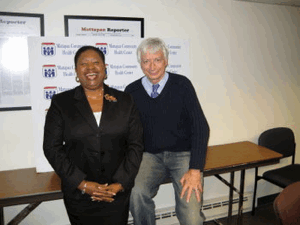
Dr. Azzie Young, president of Mattapan Community Health Center, and Dr. Michael Holick, an expert on Vitamin D at the Boston University School of Medicine.
Holick's research shows that if you're obese you're twice as likely to be deficient in Vitamin D, although researchers don't agree on the mechanism behind this relationship.
We're just beginning to understand the science of vitamin D and the research is sparking some controversy.
Many doctors say light-skinned people need 15 minutes of sun each day to get their vitamin D, but dermatologists are concerned that exposure to sunlight may lead to skin cancer. And Dr. Holick has come under fire for getting five percent of his research funding from a group that represents the indoor tanning industry.
There's not a clear consensus on a recommended dose of vitamin D either. Some experts say that adults of all skin colors should take 1,000 units of vitamin D per day and that some individuals may need more. But the government recommends much less; 200 units of vitamin D per day for newborns to teenagers, 400 for adults, and 600 for people over 70.
Dr. Mary Frances Picciano is a senior research scientist in the Office of Dietary Supplements at the National Institutes of Health.
PICCIANO: We don't have a good history of people taking high doses for long periods of time, so I am very fearful of toxicity with all this enthusiasm, quite frankly.
AHEARN: The National Academy of Sciences plans to reexamine recommended Vitamin D levels by 2010.
[WAITING ROOM SOUNDS FADE UP, CARRIBEAN FRENCH SPOKEN]
AHEARN: Back at Mattapan Community Health Center, a group of Caribbean immigrants sits in the waiting room. By the end of their first winter in Boston, they're just as deficient in Vitamin D as the patients who have lived here all their lives. Dr. Azzie Young is the president of Mattapan Community Health Center.
YOUNG: Mattapan has some of the most serious health problems in Boston, and once we learned that vitamin D deficiency is a major disease for our community we were very concerned about getting everybody on board, making sure that all of our patients have a sufficient level of vitamin D.
AHEARN: But it's not just the patients that are concerned about vitamin D. As an African American, it's on Dr. Young's mind as well.

Samuel Clemens talks with his doctor, Douglass Bibuld, about vitamin D at a recent check up at Mattapan Community Heatlh Center in Boston.
AHEARN: Now Dr. Young takes 3,000 units of vitamin D per day. That's about three times what most vitamin D experts recommend but her levels were so low, that's what it took to bring them up.
YOUNG: I'm over 40.
AHEARN: And do you feel different?
YOUNG: I feel wonderful. I can bounce out of a chair. I can walk without any problems and also I sleep better. It has made a big difference in my life and I've been spreading the word in any kind of way we can.
AHEARN: Dr. Young is working to raise awareness about vitamin D deficiency nation-wide. And research continues on the specific health benefits of vitamin D, but with more evidence that vitamin D deficiency may be associated with diseases like cancer, type II diabetes and Parkinson's, it's clear that people need to take Vitamin D supplements. Just how much we need to take is an open research question.
[WAITING ROOM SOUNDS]
For Living on Earth, I'm Ashley Ahearn in Mattapan, Massachusetts.
Family Farmacia
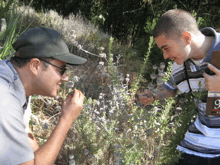
Antony Jauregui and park ranger and ethnobotanist Antonio Solorio share a moment with black sage in the Santa Monica Mountains. (Courtesy of Youth Radio)
GELLERMAN: Herbal remedies have become a huge business as people seek alternative ways to heal and ward off illness. But for Antony Jaureguí, herbal medicine isn't an alternative; it's a long-standing family tradition.
JAUREGUI: For many generations, my family has passed down the Mexican tradition of growing medicinal herbs to treat and cure everyday ailments. Because I am growing up in the U.S., I am afraid that my connections to these plants might get lost.
It's important to me not just to gain knowledge of these valuable plants, but to share it with people who could benefit from their use. Let's go on a little scavenger hunt with my mom in her garden.
[GARDEN AMBIENCE]
MRS. JAUREGUI: Sera el cambio de tierra que le hice pero me salio muy bonito . . .
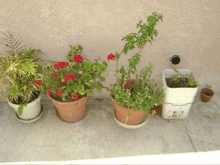
These are some of the home grown medicinal plants in Antony's mother's garden. (Courtesy of Youth Radio)
MRS. JAUREGUI: Vivia en un lugar que para todos usaban hierbas; cada ves que se enfermaba alguien-- pura hierba.
JAUREGUI: My mom says in her hometown everyone used herbs anytime someone got sick. She's explaining which illnesses can be treated with herbs.
MRS. JAUREGUI: Para insomnio, para colicos, para dolores en la espalda, la cabeza, vomito . . .
JAUREGUI: ...insomnia, back pains, nausea, headaches. My mom's list of herbal remedies cure all sorts of complaints. It's my work now to continue her tradition, and I'm trying to learn as much as I can about the plants in my region. Let's take a walk through the Santa Monica Mountains with Antonio Solorio.
[SOUND OF WATER RUNNING]
SOLORIO: This plant right here—this tree I should say-- the willow is actually a medicinal tree. And the Native Americans original to this area, which are known as the Chumash, use this as a medicine.
JAUREGUI: Antonio Solorio is an ethno-botanist and park ranger who has been studying traditional medicinal gardens in east Los Angeles.
SOLORIO: The reason why I point this willow out, if you look at your aspirin you have salicylic acid in there and so this is right here the true aspirin, you know, the original aspirin or the original medicine for a toothache or a headache, etc.
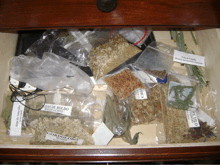
Antony is quite proud of his "loot": an assortment of dried and ground medicinal plants, which he has prepared himself. (Courtesy of Youth Radio)
SOLORIO: Growing up in East Los Angeles, in a working, poor family, we didn't have a health insurance network. Our Kaiser was my mom's backyard.
JAUREGUI: High healthcare costs have many Latino families, like Antonio's, returning to traditional medicine. But certain plant medicines found in their home countries are not available here in the U.S.
SOLORIO: Not even in the local mercados that would cater to a certain cultural group. Also when you move to an urban area, your culture—certain practices are getting replaced and it's kind of part of that whole I guess, process, of migrating.
JAUREGUI: Which gives many Latinos no back-yard alternative to expensive Western medicine. But some in the community prefer to turn away from medicinal herbs to shake a persistent stereotype.
HOLLIDAY: With Latino approaches sometimes there this idea of backwardness...
JAUREGUI: Karen Holliday is an anthropologist who spends a lot of time in botanicas, which are part-pharmacy, part-spiritual center, where many immigrants seek counseling for everything from back pains to bad luck.
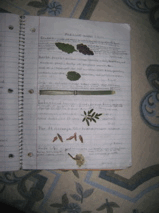
Antony cuts and pastes medicinal plants into his notebook, with information about each plant. (Courtesy of Youth Radio)
JAUREGUI: People probably aren't worshipping the devil at botanicas, but some powders and mixtures sold there are known to do more harm than good. Like when they contain poisons. One example is a powder called greta from Mexico that's used to treat indigestion. It's been found by the Centers for Disease Control and Prevention to have very high levels of lead. And there is another important reason to look beyond medicinal herbs, says Dr. Steven J. Brown from the AIDS Research Alliance in Los Angeles.
BROWN: Not to say there won't be some certain interventions that affect the illness, but I think it's important to make a distinction between the disease, which the patient has, and the illness, which people experience. Most cancers such as gastric ulcers, which has turned out to be a bacteria, need to be treated with antibiotics. Many neurological diseases such as Parkinson's or Alzheimer's can only be treated really medically.
JAUREGUI: That leaves room for plant medicine and traditional healing to treat physical symptoms. And more than that. Working with my mom in the garden, I realize it's also about the spiritual and mental satisfaction that comes from growing a plant and from preparing it.
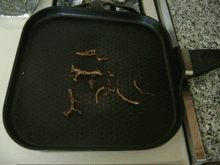
One of Antony's favorite medicinal concoctions is dandelion tea. Here he demonstrates the roasted dandelion root. (Courtesy of Youth Radio)
I often prepare my own dandelion coffee and it's actually the process in which it is made that has that soothing effect. It's supposed to be an excellent tonic for the liver. It's really good for circulation. It calms you down. Here I have some dandelion roots that we grounded, and we roasted and then we grounded. And I have it right here in my bag. Let me get the boiling water ready.
[SOUND OF POURING WATER]
JAUREGUI: I put it in my mug and we can make some dandelion coffee.
[SOUND OF SILVERWARE TOUCHING MUG]
JAUREGUI: And now I'm going to have a little sip.
[SOUND OF SIPPING TEA AND SIGH OF SATISFACTION]
JAUREGUI: For Living on Earth, I'm Antony Jáuregui.
GELLERMAN: Antony Jáuregui’s report comes to us from Youth Radio.
Related link:
Youth Radio
[MUSIC: R.E.M. “Superman” from “Life’s Rich Pageant” (Capitol Records 1986)]
Michael Recycle

Anna Carton-Smith reviewed “Michael Recycle” for Living on Earth. (Photo: Eileen Bolinsky)
GELLERMAN: Look, up in the sky, it's a bird, it's a plane! No, it's...Michael Recycle. Faster than a speeding windmill, able to leap stinking garbage dumps in a single bound, crush plastic with his bare hands – Michael Recycle is showing kids how to recycle one rhyme at a time.
He's the superhero in a kid’s book by Ellie Bethel. We challenged Michael Recycle to a tough test – kid booklover Anna Carton-Smith.

GELLERMAN: What age group do you think this is good for?
CARTON-SMITH: Well, I think it would be really fun for five, six, seven and probably eight, but like it doesn't mean that like my age or older people might not like it, too, it's just that I think that would be a very good age to read this book.
GELLERMAN: Well let's read something here from the book and see what it sounds like, ok?
CARTON-SMITH: Okay.
There once was a town called Abberdoo-Rimey
Where the garbage was left to rotten and slimy.
It never smelled fresh. The air was all hazy
But people did nothing. They got rather lazy.
GELLERMAN: Would you like to live in Abberdoo-Rimey?
CARTON-SMITH: Not at first.
GELLERMAN: How come?
CARTON-SMITH: Because it's all filthy. And nobody – everybody litters, and it's – gross.
GELLERMAN: What do you think of the rhymes?
CARTON-SMITH: I think it's really cool how they rhymed it, and it's really, like, smart, and how everything fits together.
And then something happened that none could explain.
It wasn't a bird and it wasn't a plane.
A green-caped crusader soared through the air,
With a colander hat on top of his hair.
I'm Michael Recycle! And I have a plan!
But I need your help – everyone to a man.
The sky and the river are smelly and brown.
Soon fifty-foot bugs will take over your town!
You've got to recycle! You've got to act soon!
Before all your trash reaches to the moon!
GELLERMAN: Don't you know all about recycling now? I mean you're nine years old.
CARTON-SMITH: Yes, like you can recycle, like, old food and make it dirt.
GELLERMAN: Isn't that smelly?
CARTON-SMITH: It's smelly, but it helps.
GELLERMAN: Yeah? How does it help?
CARTON-SMITH: It helps the dirt and soil and, I guess the worms, I guess. (laughs)
GELLERMAN: So why do you need a book to tell you about recycling?
CARTON-SMITH: Well, it's just also fun. So say I was nine years old and I didn't know, this would help me a lot. But even if I do know, then it'd still be really fun.
GELLERMAN: Now, do you recycle?
CARTON-SMITH: Yes.
GELLERMAN: You really do – you don't ever throw away plastic stuff, and...
CARTON-SMITH: Maybe I do sometimes, but I do recycle a lot.
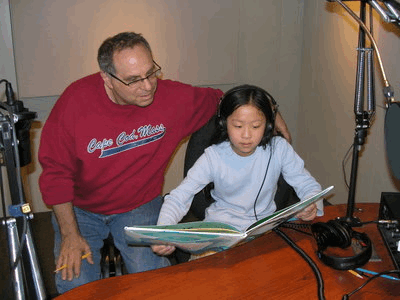
Anna Carton-Smith and host Bruce Gellerman. (Photo: Eileen Bolinsky)
CARTON-SMITH: Ah.
GELLERMAN: There you go.
CARTON-SMITH:
Then he crunched a can. He gave them a wink.
And vanished from sight before they could blink!
So if you should see a green silhouette
streaking the skies, please don't get upset.
The noise you hear – that clunk and that thunk –
It's just our friend Michael, recycling old junk!
GELLERMAN: (chuckles) You know what I like about this picture?
CARTON-SMITH: The guy's like, uh – I think he's singing.
GELLERMAN: No he's screaming. He's got like, his tonsils are hanging out. (laughs)
CARTON-SMITH: (laughs)
GELLERMAN: Do you have a brother or a sister? A younger brother or a sister?
CARTON-SMITH: Yes, I have a brother.
GELLERMAN: How old is he?
CARTON-SMITH: He's six, almost seven.
GELLERMAN: Would you want him to read this?
CARTON-SMITH: Yeah, I would, because then it would show him to recycle and stuff, because he doesn't know a lot about it, but still.
GELLERMAN: Do you think – what do you think, is it important to have books about recycling or – you already knew this stuff. I mean, here you are composting, and you –
CARTON-SMITH: Well, I, well I think that this book is important to maybe probably people who don't recycle as much, and it can show them that you should start recycling to make it better for the world. But like, it reminds me, too, again to just keep doing that, and, yea.
GELLERMAN: Well, Anna, it was a pleasure. I really enjoyed it.
CARTON-SMITH: I did too.
[MUSIC: R.E.M. “Superman” from “Life’s Rich Pageant” (Capitol Records 1986)]
GELLERMAN: Anna Carton-Smith lives in Somerville, Massachusetts. The book is 'Michael Recycle' by Ellie Bethel.
Related link:
“Michael Recycle” by Ellie Bethel, IDW Publishing
Coming up: don’t read all about it—graffiti in a national monument. Stay tuned to Living on Earth.
ANNOUNCER: Support for Living on Earth comes from Breckinridge Capital Advisors, applying a sustainable approach to fixed income investing, www.breckinridge.com, the Grantham Foundation for the protection of the environment, supporting strategic communications and collaboration in solving the world’s most pressing environmental problems, the Gordon and Betty Moore Foundation and Gilman Ordway, for conservation and environmental change. This is Living on Earth on PRI, Public Radio International.
[MUSIC: The Stryker/Slagle Band “Two Sense” from “The Scene” (Zoho Music 2008)]
The Writing on the Wall

Angelyn Bass Rivera, Architectural Conservator with the National Park Service, restores a section of a Bandelier cavate. (Courtesy of National Park Service)
GELLERMAN: It’s an encore edition of Living on Earth. I’m Bruce Gellerman. Graffiti’s typically found on subway cars and the walls, bridges and sidewalks of inner cities. But far from urban canyons you’ll also find graffiti in the remote canyons of New Mexico. At Bandelier National Monument in New Mexico, vandals have been desecrating the ancient cliff dwellings. And cleaning up the graffiti has created a conundrum – how to do it in a culturally appropriate way. Jim Williams from public radio station KUNM has our story.
[OLD SCREEN DOOR SQUEAKING OPEN AND CLOSED]
WILLIAMS: Larry Humetewa steps out of his old stone building office with a couple of buckets. He's about to head up the canyon trail here in New Mexico's Bandelier National Monument to deal with graffiti park visitors have left on some of the 800-year old cliff dwellings.
HUMETEWA: We have to bring out our field material, which consists of a couple of different clays, some red tuff, grey tuff, trail sand, tools we call microspatulas.
WILLIAMS: Humetewa is on the restoration team for Vanishing Treasures, a National Park Service program that has, since the late 1990s, provided extra funding and expertise to help protect and stabilize ancient archeological sites at national parks and monuments across the Southwest. The program's been called a "last defense" against losing sites like these. And there is plenty of defending to do. In the case of Bandelier's graffiti, up to a quarter of the 1100 ancestral pueblo sites here have now been vandalized by visitors. Humetewa is from Santo Domingo Pueblo, a reservation about forty miles to the south of here. It's likely his ancestors built these ancient dwellings.
HUMETEWA: You know, it's very important. I do feel that connection, you know.
[FRIJOLES CREEK, WIND IN TREES]
WILLIAMS: Frijoles Creek runs through a beautiful forest of old ponderosa pine, douglas fir, and gambel oak along the canyon bottom here in Bandelier. Through the trees, on either side, the sun shines on cliff walls that rise hundreds of feet into the air. They're filled with ancestral dwellings used by generations of American Indians. Humetewa glances up at them.
[WALKING ALONG CREEKSIDE TRAIL]
HUMETEWA: Every time I, you know, drive down the hill, it's a special place. And knowing that my ancestors lived here and played here and worked here, and made pots and textiles here. You know, I try to stay positive while I'm working, you know basically what we're always told to do: just stay positive, respect the place and the people that lived here.
WILLIAMS: On the way up the trail toward the cliffs, we pass a sign that states clearly: "it's illegal to deface cave dwellings."
HUMETEWA: Yeah, I think they oughta, I don't know, put more signs in different languages. [laughs] I don't know. They just seem to ignore them. Even way down there where we're working at, there's signs, you know, right in front of you.
[CLIMBING SQUEAKY WOODEN LADDER]
WILLIAMS: We climb the ladder made out of small logs up into one of the cavates, a round room about eight feet high and fifteen feet deep carved into the compressed volcanic ash, or "tuff," of the cliff wall.
HUMETEWA: We probably started "c", and then an "o" over here.
WILLIAMS: Humetewa waves his hand across where someone had carved the name of an old Spanish conquistador, Coronado. In another spot, a visitor had written his own name: Leonardo. That one was difficult to cover because it sprawled across the wall. But if Humetewa wasn't pointing at it, no one would ever know it'd been there.
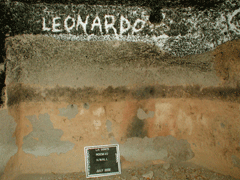
Leonardo carved his name on this ancient cavate wall. (Courtesy of National Park Service)
WILLIAMS: That's clearly important to Humetewa, because he takes the graffiti personally.
HUMETEWA: To me, it's like coming into my house and carving your name on my wall. You know, that's how I feel that these are disrespectful. I wouldn't go into anybody's house and carve my name into their wall.
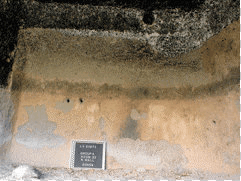
The same cavate wall after graffiti mitigation treatment. (Courtesy of National Park Service)
[SCRAPING AND MIXING IN A SMALL CUP]
HUMETEWA: Yeah, you don't wanna add too much water 'cause it's just gonna get too watery...
[SPRAYING WATER]
WILLIAMS: Humetewa sprays water over the graffiti to moisten the wall so the material will stick to it. The mix is then carefully applied by spatula over the carved graffiti.
[SPATULA SCRAPES]
[VISITORS TALKING IN ANOTHER CAVE]
MCMAHON: The graffiti in this cave is so severe...before it was treated it was so severe that there was basically little to no original material left.
WILLIAMS: That's Conor McMahon, Humetewa's restoration partner. This cavate, about three hundred feet down the cliff from the other, originally had a black ceiling, created by centuries of smoke from burning wood in it. It has, over time, become a chalkboard of sorts for people to carve their own messages: initials, names, profanity. McMahon says that here, he and Humetewa had to break from their traditional method of just covering over individual graffiti markings. As many as four times a year, in the hot high desert sun, they have to re-soot the whole thing.
MCMAHON: So basically what we do is we come in here with small pieces of highly resinous wood, essentially fire starters, kindling. We close the cavate, we come in here with full respirators, and we light these pieces of wood, and re-smoke the entire upper half of the kiva.
WILLIAMS: This room, and many others like it here, were sacred places for generations, and to their descendants they still are.
MEYER: Their perspective on sites like this are that these sites are still occupied by their ancestors - that life is very cyclical.
WILLIAMS: Lauren Meyer is an architectural conservator with the Vanishing Treasures Program at Bandelier. She says the program has consulted with the current pueblo people in the area, including Larry Humetewa, to make sure restoration is done correctly.
MEYER: You know, their ancestors live on in these sites, and these sites, you know, are supposed to erode naturally. It's all about coming from the earth and going back to the earth, and Larry brings that perspective to us which helps inform our decisions about treating these sites.
[BIRDS, CREEK]
WILLIAMS: About 25,000 dollars a year is dedicated to treating these sites at Bandelier. Lauren Meyer and other preservation advocates say that's barely enough to continually treat them and educate the public about their cultural history. The Vanishing Treasures program focuses almost exclusively on Southwest parks, where many ancient cultural sites exist. But other national parks and monuments around the country have little funding for restoration programs. One former parks director called the lack of funding "an undeniable crisis in care" and it's sure to affect historical parks around the country for years to come.
For Living On Earth, I'm Jim Williams in Bandelier National Monument in New Mexico.
Related links:
- Vanishing Treasures Program
- Bandelier National Monument
[MUSIC: Daniel Lanois "O Marie (Homeground Theme)" from 'Acadie' (Daniellanois.com – 2005)]
The Language of Landscape
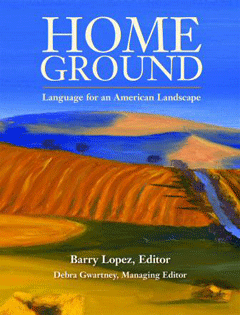
Detail of natural cavities and architectural carving into the soft tuff. (Photo: Wikimedia)
GELLERMAN: Bandelier National Monument gets its name from Adolph Bandelier, a Swiss archeologist who studied ancient Pueblo Indian sites. The names we use to describe places and landforms often have origins and meanings that are lost to us now…so from time to time we turn to the book: “Home Ground; Language for an American Landscape” to remind us where the terms that define our environment come from.
The book was compiled by Barry Lopez and Debra Gwartney–and today – poet Pattiann Rogers describes: “kiss tank”.
ROGERS: Kiss tank. Walking across the hot, dry lands, through saltbush and snakeweed and desert sage, the tired travelers longed for the sight of a kiss tank, a pool of water left from the last rain and its runoff in a naturally formed rock basin. Ranchers call these pools of water kiss tanks because, when such a pool is found, all creatures of the desert, as well as cattle and horses and humans, put their dry lips and thirsty mouths to its water eagerly, with a kind of passion. And they rise refreshed.
Such basins filled with the water from snowmelt can also be found in mountainous regions. A basin on top of the Maiden, a sandstone spire near Boulder, Colorado, for instance, contains freshwater shrimp that have evolved to survive the dry seasons. A kiss tank is also called a tinaja, which is Spanish for a big, earthen jar.
GELLERMAN: Poet Pattiann Rogers lives in Colorado. Her definition of Kiss tank appears in the book: "Home Ground: Language for an American Landscape" edited by Barry Lopez and Debra Gwartney.
Related link:
Home Ground Project
[MUSIC: Eco-Elvis "Earth Day Rock" from 'Burnin' Globe' (Matt Riggs – 2006)]
Eco Elvis

Eco Elvis aka Matt Riggs entertains audiences with environmental messages. (Courtesy of Matt Riggs)
GELLERMAN: The king is alive, well – and recycled – in Kansas City, MO.
[MUSIC: Eco-Elvis "Earth Day Rock" from 'Burnin' Globe' (Matt Riggs – 2006)]
GELLERMAN: Eco-Elvis – green sequin jumpsuit, sideburns and shades – is Matt Riggs, and this is one of the cuts off his CD 'Burnin' Globe.'
[MUSIC: Eco-Elvis "Earth Day Rock" from 'Burnin' Globe' (Matt Riggs – 2006)]
GELLERMAN: Eco Elvis's disc includes a dozen tunes from the King's collection of smash hits, retooled with environmental messages. Matt Riggs has entered the building at the studio of KCUR in Kansas City. Matt, it is a real thrill.
RIGGS: (imitating Elvis' voice) Well thank you very much for having me, man.
GELLERMAN: (laughs) How'd you come up with the inspiration for Eco-Elvis?
RIGGS: Eco-Elvis came about eleven years ago. I was working at a non-profit group here in Kansas City, Missouri, and we were kicking off a recycling program in an office building. And my coworker friend and I were there – we were basically giving out recycling bins, and it was really, really getting boring. And I was thinking, you know, we really need something to make these things more fun and more exciting and interesting.
It was August 16th, the day of Elvis's death, and in walked an Elvis impersonator, and I saw that Elvis impersonator and it just clicked, and I said, that's what we need – we need an Eco-Elvis – or back then I was calling myself Green Elvis, but now I'm Eco-Elvis, but regardless, that's how it came into being.
GELLERMAN: So from those humble origins, a king was born.
RIGGS: That's right.
[MUSIC: Eco-Elvis "Viva Las Vegans" from 'Burnin' Globe' (Matt Riggs – 2006)]
GELLERMAN: Where do the words come from? Is it hard to make up the words to the tunes?
RIGGS: Actually, it's – well like with the song "I Reduce, I Reuse, I Recycle," it's kind of a, a phrasing thing. You know it's like, "I Want You, I Need You, I Love You" is the song it's based on, and I just was thinking, 'hmm, that's got three words and "reduce, reuse, recycle" is three words,' and it just – it went from there. The rest of it kind of wrote itself, as it were.
GELLERMAN: Well, let's listen to a little bit of "I Reduce, I Reuse, and I Recycle."
[MUSIC: Eco-Elvis "I Reduce, I Reuse and I Recycle" from 'Burnin' Globe' (Matt Riggs – 2006): "I use less energy, buy less stuff, use less water, yes it's tough, I walk or bike instead of taking the car, I reduce, I reuse, I recycle, with all my heart. I eat only what I need, on the food chain's where I feed, baby..."]
GELLERMAN: (laughing) Matt, I'm in tears.
RIGGS: (laughs)
[MUSIC: Eco-Elvis "I Reduce, I Reuse and I Recycle" from 'Burnin' Globe' (Matt Riggs – 2006):
"...I reduce, I reuse, I recycle, more and more, hear me talkin', baby, hear me talkin'. Well I thought that..."]
GELLERMAN: Your, your outfit – what is it made out of? It looks like an Elvis outfit.
RIGGS: Well, yeah. I try to kind of strike a balance between ecological principles and the need for flash. So part of it's recycled, like the belt is recycled – it's an old weight belt turned around, painted green, uh, then I got bottle caps on there, and then I have pop tabs running up and down the seams of the suit. Without the costume I'm about 6'3", and with – between the hair and the heels on my boots – it's going, it's pushin' seven feet. So it can be quite an intimidating character to enter the room.
GELLERMAN: I like the green Hawaiian lei. That adds a very nice touch.
RIGGS: Yeah (laughs), that classes it up a lot I think.
[MUSIC: Eco-Elvis "Compost Hotel" from 'Burnin' Globe' (Matt Riggs – 2006): "Well...since the landfills are fillin' up, and yard waste isn't allowed, a place that used to waste a lot is now compost hotel, well, it's more friendly baby, it's more friendly, it gives that garbage a second life, well..."]
GELLERMAN: One of my favorites on the CD is your cover of "Heartbreak Hotel."
RIGGS: Have you ever visited the compost hotel?
GELLERMAN: (laughs)
RIGGS: That's a question I always ask my audiences (laughs).
[MUSIC: Eco-Elvis "Compost Hotel" from 'Burnin' Globe' (Matt Riggs – 2006): "Well the kitchen staff started recycling the bread and vegetable scraps, even the paper towels and coffee filters ladies and gentleman – can go to that compost bin out back, well, it's more friendly, baby..."]
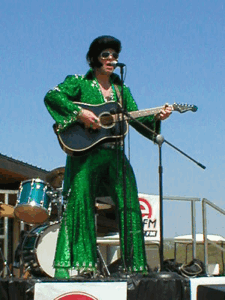
Eco Elvis aka Matt Riggs entertains audiences with environmental messages. (Courtesy of Matt Riggs)
RIGGS: I do, strangely enough (laughs), I mean. I don't actually think that I am Elvis – there are some people out there that think that I am, and that kind of scares me sometimes, but I – it's kind of weird, I put that on, and it kind of – you feel that, the power of Elvis kind of come over me – and the confidence he has and the showmanship, and it's a whole different manner of speaking and acting, and I just kind of totally morph into that character while the costume's on, so.
GELLERMAN: If the king were alive today, you think he would like it? Or would he roll over in his grave? (laughs)
RIGGS: (laughs) I think he would probably like it...is my guess. You know he had a lot of problems, but underneath it he was a humanitarian, he was a good person, and I think given today's dire environmental situation he would probably understand and, you know, say (in Elvis voice) 'go for it, man!'
GELLERMAN: Well, I want to take it down a notch. Let's listen to your version of 'Can't Help Falling In Love.'
RIGGS: Okay.
[MUSIC: Eco-Elvis "I Can't Help Recycling It All" from 'Burnin' Globe' (Matt Riggs – 2006): "...but I can't help recycling it all, it's true. All creeds say, it is wrong to waste, that's why I can't help recycling it all, it's true. Tiny bits of foil, lids and bottle caps, even post-it notes, I recycle the price-tags off my clothes – yes I do darlin'!"]
GELLERMAN: (laughs) I love that line!
(laughs)
GELLERMAN: (laughing) 'I recycle the price tags off my clothes.'
[MUSIC: Eco-Elvis "I Can't Help Recycling It All" from 'Burnin' Globe' (Matt Riggs – 2006)]
GELLERMAN: You know, Matt, it really does have a message.
RIGGS: Mm-hmm. When I started doing Eco-Elvis, it was more to kind of bring excitement to what I thought were kind of dull events. Doesn't really do much for the cause when people are falling asleep. So I thought, well, Eco-Elvis, you know it's like, if the flashy costume doesn't get 'em the music will, and if the music doesn't get 'em the jokes I crack will, and the antics will. So, you know and if that doesn't get 'em then the message and the words will get 'em. So it's kind of like a, you know, four or five tier punch – if I can't get 'em one way, I'll get 'em another.
GELLERMAN: Well I've always wanted to say this. Matt, (impersonating Elvis' voice) thank ya, thank ya very much! (laughs)
RIGGS: (in Elvis' voice) You're welcome, man. Stop by Graceland sometime. I'll show ya around baby.
[MUSIC: Eco-Elvis "Let's Go Organic" from 'Burnin' Globe' (Matt Riggs – 2006): "Let's go organic, let's do what's right, say no to poisons with all your might. In action we'll seal our fate, let's go organic, the Earth can't wait. Few people realize that our health is in danger, our food is tainted by poisons we pay for. They damage our bodies and can even be fatal, farm workers are killed, our children grow ill, so I say...."]
GELLERMAN: Matt Riggs aka Eco-Elvis has left the building. But you can catch a video of the recycled king at our website, loe.org.
Related links:
- Click here to see a video of Eco Elvis.
- Eco Elvis' Homepage
[MUSIC: Eco-Elvis "Let's Go Organic" from 'Burnin' Globe' (Matt Riggs – 2006): "Let's go organic, let's do what's right, say no to poisons with all your might. In action we'll seal our fate, let's go organic, the Earth can't wait. Few people realize that our health is in danger, our food is tainted by poisons we pay for. They damage our bodies and can even be fatal, farm workers are killed, our children grow ill, so I say...."]
GELLERMAN: Living on Earth is produced by the World Media Foundation. Our crew includes Bobby Bascomb, Eileen Bolinsky, Helen Palmer, Jessica Ilyse Smith, and Ike Sriskandarajah, with help from Sammy Souza. Jeff Turton is our technical director. This show was engineered by Dana Chisholm. Alison Lirish Dean composed our themes. Our executive producer is Steve Curwood. You can find us anytime at LOE dot org. I’m Bruce Gellerman - thanks for listening.
ANNOUNCER: Funding for Living On Earth comes from the National Science Foundation, supporting coverage of emerging science. And Stonyfield Farm, organic yogurt and smoothies. Stonyfield invites you to just eat organic for a day. Details at just eat organic dot com. Support also comes from you, our listeners, the Go Forward Fund, the Grantham Foundation for the Protection of the Environment, supporting strategic communications and collaboration in solving the world's most pressing environmental problems, the Gordon and Betty Moore Foundation, and Gilman Ordway - for coverage of conservation and environmental change, and Pax World Mutual and Exchange-Traded Funds, integrating environmental, social, and governance factors into investment analysis and decision making. On the web at pax world dot com. Pax world, for tomorrow.
PRI ANNOUNCER: PRI, Public Radio International.
Living on Earth wants to hear from you!
Living on Earth
62 Calef Highway, Suite 212
Lee, NH 03861
Telephone: 617-287-4121
E-mail: comments@loe.org
Newsletter [Click here]
Donate to Living on Earth!
Living on Earth is an independent media program and relies entirely on contributions from listeners and institutions supporting public service. Please donate now to preserve an independent environmental voice.
NewsletterLiving on Earth offers a weekly delivery of the show's rundown to your mailbox. Sign up for our newsletter today!
 Sailors For The Sea: Be the change you want to sea.
Sailors For The Sea: Be the change you want to sea.
 The Grantham Foundation for the Protection of the Environment: Committed to protecting and improving the health of the global environment.
The Grantham Foundation for the Protection of the Environment: Committed to protecting and improving the health of the global environment.
 Contribute to Living on Earth and receive, as our gift to you, an archival print of one of Mark Seth Lender's extraordinary wildlife photographs. Follow the link to see Mark's current collection of photographs.
Contribute to Living on Earth and receive, as our gift to you, an archival print of one of Mark Seth Lender's extraordinary wildlife photographs. Follow the link to see Mark's current collection of photographs.
 Buy a signed copy of Mark Seth Lender's book Smeagull the Seagull & support Living on Earth
Buy a signed copy of Mark Seth Lender's book Smeagull the Seagull & support Living on Earth

